Constitutive metaphor and mental mappings: meaning construction in the language of science and technology
Palabras clave:
languages for specific purposes, linguistics, applied linguistics, specialised discourse, discourse studies, pragmatics, language teaching, translation, interpreting, English for specific purposes, pedagogyResumen
The study of scientific and technical language, where metaphor is central, is enriched by the cognitive linguistics approach. This paper is based on the research project that culminated in the Bilingual Dictionary of Scientific and Technical Metaphors and Metonymies, developed to depict metaphorical terms and mental mappings, thus unfolding cognitive metaphors in science and technology. Although terminological metaphors as a whole exceed widely in number those that constitute part of conceptual metaphors, the importance of the latter radicates in its relevance as a constitutive element of scientific thought and language. Focusing on the analysis of metaphorical terms from earth sciences, agronomy, and mechanical engineering, the study reveals the presence of several conceptual metaphors, typified as ‘humanizing’, ‘organicist’, and ‘objectual’, according to their source domain’s nature. The work presents some very productive conceptual metaphorical patterns found in knowledge representation in engineering, in English and in Spanish, and shows evidence that metaphorical reasoning is a mechanism present at the core of creative scientific development albeit certain socio-cultural variations. This contribution opens a door for further research on the role of metaphor in constructing meaning within all branches of science and technology, as well as on the study of knowledge representation variations in different languages and cultures.Descargas
Citas
Boyd, R. (1993). ‘Metaphor and theory change: What is metaphor a metaphor for?’ In A. Ortony (Ed.) Metaphor and Thought (pp. 481-532). Cambridge: Cambridge University Press.
Brown, T. (2008). Making Truth. Metaphor is Science. Illinois: University of Illinois Press.
Caballero, R. and Diaz-Vera, J. (2013). Sensuous Cognition. Explorations into Human Sentience, Imagination, (E)motion and Perception. Berlin & New York: Mouton de Gruyter.
Ciapuscio, G. (2011). De metáforas durmientes, endurecidas y nómadas: un enfoque lingüístico de las metáforas en la comunicación de la ciencia. Arbor Ciencia, Pensamiento y Cultura, 187, 89-98.
Cuadrado Esclapez, G. (2010). Un sistema de engranajes es un sistema planetario: análisis de la metáfora cognitiva y los modelos mentales en la ingeniería. In T. Bungarten (Ed.), Akten des IX. Internationaler Kongress Der Europäischen Gesellschaft Für Fachsprachen (pp.1-9). Hamburg: Universität Hamburg.
Cuadrado, G. and Durán, P. (2013a). Proposal for a Semantic Hierarchy of Terminological Metaphors in Science and Technology. International Journal of English Linguistics, 3(4), 1-15.
Cuadrado, G. and Durán, P. (2013b). <>. Researching the humanizing metaphor in Earth Science Scientific Texts. Global Journal of Human Social Science, 13(7), 53-63.
Durán Escribano, P. and Argüelles Álvarez, I. (2016). Cross-Disciplinary Metaphorical Meaning Extension in the Creation of New Scientific Terms. In M.F. Litzler., J. García Laborda & C. Tejedor Martínez (Eds.), Beyond the universe of Languages for Specific Purposes: the 21st century perspective (pp. 107-110). Alcalá de Henares: Publicaciones Universidad de Alcalá.
Evans, V. (2013). Metaphor, Lexical Concepts and Figurative Meaning Construction. Journal of Cognitive Semiotics, 1(2), 73-107
Fahnestock, J. (1999). Rhetorical Figures in Science. New York: Oxford University Press.
Fauconnier, G. (1997). Mappings in Thought and Language. Cambridge:
Cambridge University Press.
Johnson, M. (1997). Embodied Meaning and Cognitive Science. In D. Levin (Ed.), Language beyond Postmodernism: Saying and Thinking in Gendlin Philosophy (pp. 148-175). Evanston, IL: Northwestern University Press.
Johnson-Sheehan, R. (1997). The Emergence of a Root Metaphor in Modern Physics: Max Planck´s Quantum Metaphor. Technical Writing and Communication, 27(2), 177-190.
Kövecses, Z. (2010). Metaphor and Culture. Acta Universitatis Sapientiae Philologica, 2(2), 197-220.
Lakoff, G. (1987). Women, Fire and Dangerous Things. What Categories Reveal about the Mind. Chicago: University of Chicago Press.
Lakoff, G. and Turner, M. (1989). More Than Cool Reason. Chicago: University of Chicago Press.
Lakoff, G. (1993). The Contemporary Theory of Metaphor. In A. Ortony (Ed.), Metaphor and Thought (pp. 202-251). Cambridge: Cambridge University Press.
Lakoff, G. and M. Johnson (1980). Metaphors We Live By. Chicago: The University of Chicago Press.
Lakoff, G. and Johnson, M. (1999). Philosophy in the Flesh. The Embodied Mind and its Challenge to Western Thought. New York: Basic Books.
Low, G. (1999). Validating metaphor research projects. In L. Cameron and G. Low (Eds.), Researching and Applying Metaphor (pp. 48-66). Cambridge: Cambridge University Press.
Musolff, A. (2009). “Progressive” evolution and “totipotent” stem cells: metaphors in British and German debates about the “life sciences”. IBÉRICA, 17, 45-60.
Pragglejaz Group (2007). MIP: a method for identifying metaphorically used words in discourse. Metaphor and Symbol, 22, 1-39.
Robisco Mª M. (2011). Análisis Cognitivo de las preposiciones en torno al eje de verticalidad en el inglés para la aeronáutica. Madrid: Editorial Doppel.
Roldán-Riejos, A. and Molina Plaza, S. (2016). Home and Clothes: A Case of Prolific Metaphor Creation in Engineering (Spanish and English). SYNERGY, 12(1), 129-138.
Roldán-Riejos, A. and Úbeda Mansilla, P. (2013). Metaphor in the ESP engineering context. IBÉRICA, 25, 107-126.
Rosch, E. (1978). Principles of Categorization. In Rosch, E. & Lloyd,
B.B. (Eds.), Cognition and Categorization (pp. 27–48). Hillsdale, NJ:
Lawrence Erlbaum Associates.
Salager-Meyer, F. (1990). Metaphors in medical English prose: A comparative study with French and Spanish. English for Specific Purposes, 9, 145-159.
Siqueira, M., Souto de Oliveira, A.F., Dienstbach Huber, D., Faé de Almeida, G. and Moreira Brangel, L. (2009). Metaphor identification in a terminological dictionary. IBÉRICA, 17, 157-174.
White, M. (2004). Turbulence and turmoil in the market or the language of a financial crisis. IBÉRICA, 7, 71-86.
Dictionaries
Allaby, M. (2003/2008). Oxford Dictionary of Geology and Earth Sciences. Oxford: Oxford University Press. Published online 2015.
Alonso Matilla, L. A. (2004/2009). Diccionario Oxford-Complutense de Ciencias de la Tierra, con Vocabulario traducido inglés/ español. Madrid: Editorial Complutense.
Atking, T. and Escudier, M. (2014). Oxford Dictionary of Mechanical Engineering. Oxford: Oxford University Press.
Beigbeder Atienza, F. (1988). Nuevo Diccionario Politécnico de las Lenguas Española e Inglesa. English / Spanish. New Polytechnic Dictionary of Spanish & English Language. Spanish/English. Madrid: Diaz de Santos S.A.
Chhatwal, M. (1998/2004). Anmol’s Dictionary of Geology. New Delhi: Anmol Publications,
Collins English Dictionary. <https://www.collinsdictionary.com/dictionary>
Cuadrado, G., Argüelles, I., Durán, P., Gómez, M-J, Molina, S., Pierce, J., Robisco, MM., Roldán, A. and Úbeda, P. (2016). Diccionario Científico-Técnico de Metáforas y Metonimias (Español-Inglés/Inglés-Español). Oxford: Routledge.
Howard, D. (2005). The Penguin Dictionary of Electronics. London: Penguin.
McGraw-Hill Education. (2000). The McGraw-Hill Dictionary of Scientific and Technical Terms (2000). New York: McGraw-Hill, 7th ed.
Oxford English Dictionary. <https://www.oxforddictionaries.com/english>
Park, C. and Allaby, M. (2007). Oxford Dictionary of Environment and Conservation. Oxford: Oxford University Press. Published online 2017.
Thrust, P. W. (Ed.) (1968/1990). Dictionary of Mining, Mineral, and related terms. Chicago: US Department of the Interior.
Descargas
Publicado
Cómo citar
Número
Sección
Licencia
Aquellos autores/as que tengan publicaciones con esta revista, aceptan los términos siguientes:
- Los autores/as conservarán sus derechos de autor y garantizarán a la revista el derecho de primera publicación de su obra, el cuál estará simultáneamente sujeto a la Licencia de reconocimiento de Creative Commons que permite a terceros compartir la obra siempre que se indique su autor y su primera publicación esta revista.
- Los autores/as podrán adoptar otros acuerdos de licencia no exclusiva de distribución de la versión de la obra publicada (p. ej.: depositarla en un archivo telemático institucional o publicarla en un volumen monográfico) siempre que se indique la publicación inicial en esta revista.
- Se permite y recomienda a los autores/as difundir su obra a través de Internet (p. ej.: en archivos telemáticos institucionales o en su página web) antes y durante el proceso de envío, lo cual puede producir intercambios interesantes y aumentar las citas de la obra publicada. (Véase El efecto del acceso abierto).

Revista de Lenguas para fines específicos is licensed under a Creative Commons Reconocimiento-NoComercial-SinObraDerivada 4.0 Internacional License.






















